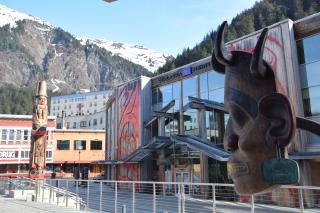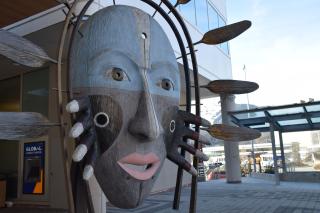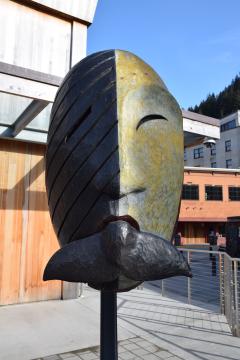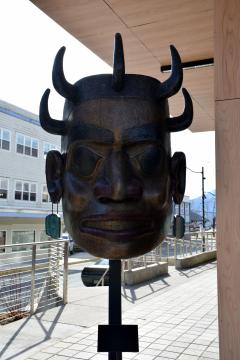Alaska Region honored to be part of Faces of Alaska

ALASKA—The Alaska Region is home to an Indigenous history and heritage that goes back over 10,000 years. A new exhibit by Sealaska Heritage Institute in Juneau shows the rich artistry and culture of Alaska’s five major Native groups. The “Faces of Alaska” exhibit features large, bronze masks created by master Native artists.
The Forest Service awarded a $70,000 grant to support the initiative, contributing to the mask created by Southeast Alaska Indigenous artist Jack Hudson.
“We were deeply honored to be a part of the Faces of Alaska project,” commented Acting Alaska Regional Forester Chad VanOrmer. “These works of art are breathtakingly inspiring, and we hope they might serve as a centerpiece for discussion and education about Alaska’s diverse cultural groups.”
The most recent mask to be installed honors the Tlingit, Haida and Tsimshian peoples of Southeast Alaska. Others celebrate the Iñupiaq, Yup'ik and Alutiiq/Sugpiaq peoples, with an Athabascan mask to be installed in the next year.
Sealaska Heritage Institute Communications and Publications Director Ricardo Worl explained that the art installation is part of the institute’s greater vision of making Juneau the Northwest Coast arts capital of the world, supporting Indigenous arts and artists, creating a visitor experience rooted in respect and reciprocity, and promoting cultural and historical knowledge.
The outdoor plaza in the center of downtown Juneau where the masks are on display is popular with visitors. Sealaska Heritage saw this as an opportunity to promote cultural learning. “With the 1.5 million visitors coming through Juneau, we see this as a gateway to Alaska’s other four major Indigenous cultural groups,” Worl noted.
Forest Service funding aligns with the Native American Tourism & Improving Visitor Experience Act. This public law promotes a more inclusive national travel and tourism strategy. It has the potential to deliver significant benefits for tribes, including job creation, elevated living standards and expanded economic opportunities.
This landmark project supports economic opportunities benefiting tribal artisans from rural communities while enhancing authentic cultural tourism opportunities.



